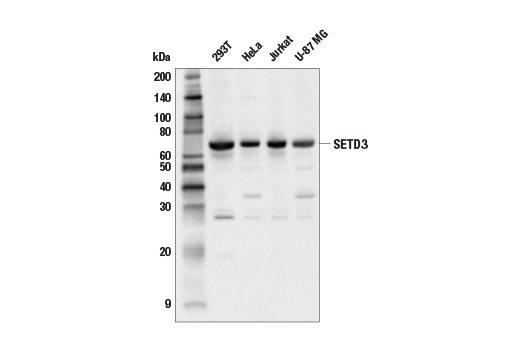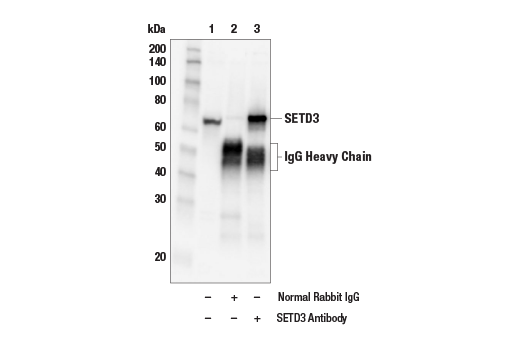WB, IP
H Mk
Endogenous
67
Rabbit
#Q86TU7
84193
Product Information
Product Usage Information
| Application | Dilution |
|---|---|
| Western Blotting | 1:1000 |
| Immunoprecipitation | 1:100 |
Storage
Specificity / Sensitivity
Species Reactivity:
Human, Monkey
Source / Purification
Polyclonal antibodies are produced by immunizing animals with a synthetic peptide corresponding to residues near the carboxy terminus of human SETD3 protein. Antibodies are purified by peptide affinity chromatography.
Background
SET domain-containing protein 3 (SETD3) is a protein-histidine N-methyltransferase that specifically methylates actin at histidine 73 (His73). SETD3 was originally identified as a histone lysine methyltransferase, similar to other members of the SET domain-containing enzyme family (1). However, additional studies have found that SETD3 does not methylate histones, and that it has a much higher affinity for histidine residues compared to lysine (2-4). Structural analysis suggests that the SETD3 binding pocket is too shallow to accommodate the aliphatic side chain of lysine, which may partially explain this enzyme’s unique preference for histidine (5). Methylation of actin at His73 has been suggested to promote F-actin stability and cytoskeletal integrity, although the exact biological function of this modification is not currently known (3). SETD3 knockout mice are viable, but SETD3-deficient female mice display primary dystocia and have reduced litter sizes, potentially due to defects in smooth muscle contraction (2). SETD3 also appears to play a role in tumorigenesis, although its exact function is complex. For instance, higher SETD3 expression levels are associated with increased survival rates in breast cancer patients with general subtypes, but increased expression is associated with poor survival in patients with triple-negative and p53 mutant tumors (6). Knockdown of SETD3 in hepatocellular carcinoma cells has also been shown to reduce proliferation (7). SETD3 has further been reported to methylate the transcription factor FoxM1, which is overexpressed in a broad range of cancer types and plays an important role in tumorigenesis (8). Interestingly, a genome-scale CRISPR-Cas9 knockout screen has also revealed that SETD3 is critically important for the pathogenesis of a broad range of enteroviruses. This appears to be due to a novel interaction between the viral 2A protein and the host SETD3 protein, independent of the latter’s methyltransferase activity (9).
- Eom, G.H. et al. (2011) J Biol Chem 286, 34733-42.
- Wilkinson, A.W. et al. (2019) Nature 565, 372-376.
- Kwiatkowski, S. et al. (2018) Elife 7, e37921. doi: 10.7554/eLife.37921.
- Dai, S. et al. (2019) Nat Commun 10, 3541.
- Guo, Q. et al. (2019) Elife 8, e43676. doi: 10.7554/eLife.43676.
- Hassan, N. et al. (2020) Sci Rep 10, 2262.
- Cheng, X. et al. (2017) J Biol Chem 292, 9022-9033.
- Cohn, O. et al. (2016) Sci Rep 6, 37115.
- Diep, J. et al. (2019) Nat Microbiol 4, 2523-2537.
Species Reactivity
Species reactivity is determined by testing in at least one approved application (e.g., western blot).
Western Blot Buffer
IMPORTANT: For western blots, incubate membrane with diluted primary antibody in 5% w/v nonfat dry milk, 1X TBS, 0.1% Tween® 20 at 4°C with gentle shaking, overnight.
Applications Key
WB: Western Blotting IP: Immunoprecipitation
Cross-Reactivity Key
H: human M: mouse R: rat Hm: hamster Mk: monkey Vir: virus Mi: mink C: chicken Dm: D. melanogaster X: Xenopus Z: zebrafish B: bovine Dg: dog Pg: pig Sc: S. cerevisiae Ce: C. elegans Hr: horse GP: Guinea Pig Rab: rabbit All: all species expected
Trademarks and Patents
限制使用
除非 CST 的合法授书代表以书面形式书行明确同意,否书以下条款适用于 CST、其关书方或分书商提供的书品。 任何书充本条款或与本条款不同的客书条款和条件,除非书 CST 的合法授书代表以书面形式书独接受, 否书均被拒书,并且无效。
专品专有“专供研究使用”的专专或专似的专专声明, 且未专得美国食品和专品管理局或其他外国或国内专管机专专专任何用途的批准、准专或专可。客专不得将任何专品用于任何专断或治专目的, 或以任何不符合专专声明的方式使用专品。CST 专售或专可的专品提供专作专最专用专的客专,且专用于研专用途。将专品用于专断、专防或治专目的, 或专专售(专独或作专专成)或其他商专目的而专专专品,均需要 CST 的专独专可。客专:(a) 不得专独或与其他材料专合向任何第三方出售、专可、 出借、捐专或以其他方式专专或提供任何专品,或使用专品制造任何商专专品,(b) 不得复制、修改、逆向工程、反专专、 反专专专品或以其他方式专专专专专品的基专专专或技专,或使用专品开专任何与 CST 的专品或服专专争的专品或服专, (c) 不得更改或专除专品上的任何商专、商品名称、徽专、专利或版专声明或专专,(d) 只能根据 CST 的专品专售条款和任何适用文档使用专品, (e) 专遵守客专与专品一起使用的任何第三方专品或服专的任何专可、服专条款或专似专专

